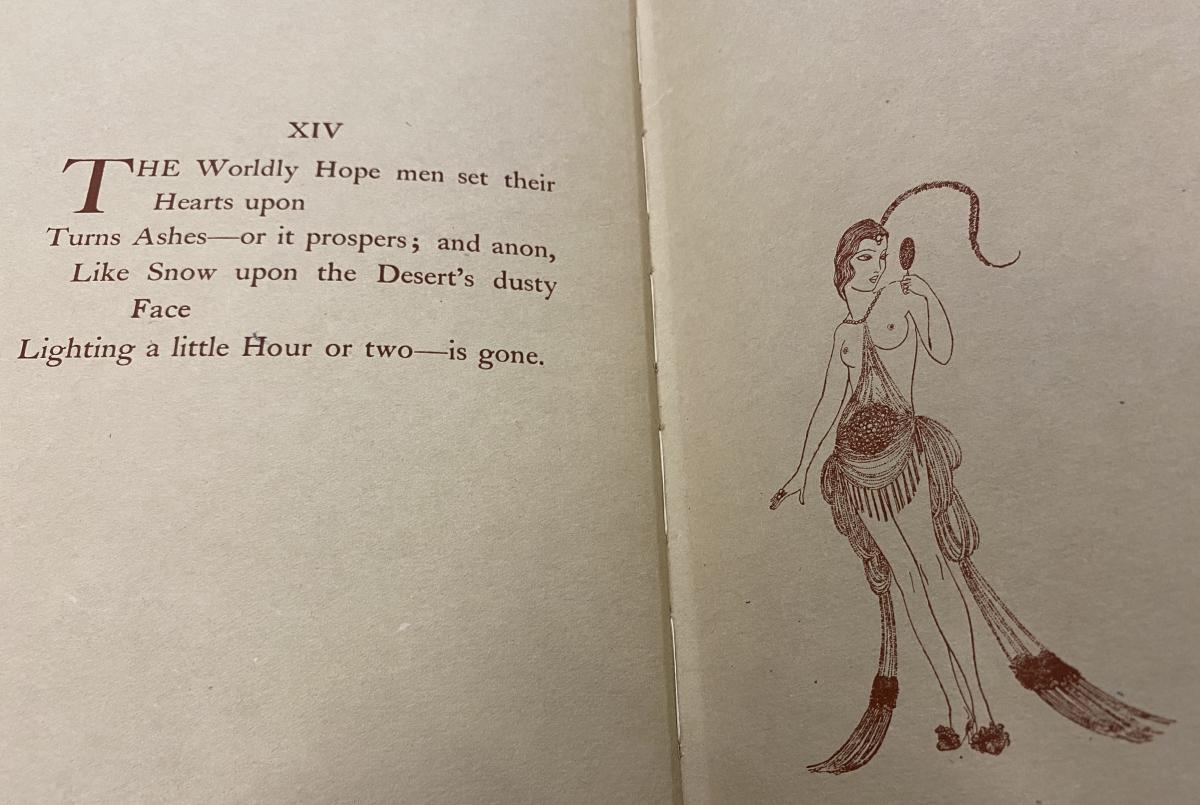In this Ronald Balfour-illustrated edition of Omar Khayyám’s Rubáiyát, Balfour devotes an illustration to each stanza, and the majority of these images depict beautiful (i.e., according to western conventions) and frequently nude women. Understandably, it could be argued that certain illustrations do not conceptually synchronize with their corresponding stanzas; for instance, how does a partially naked woman pertain to a muezzin crying from the tower of darkness in Stanza XXV? Still, at the same time, there are numerous instances where the stanza and Balfour’s illustration are either overtly or covertly linked. One such case is Stanza XIV:
The worldly Hope Men set their Hearts upon,
Turns Ashes—or it prospers; and anon,
Like Snow upon the Desert’s dusty Face
Lighting a little Hour or two—is gone.
In Balfour’s Rubaiyat of Omar Khayyam, his illustration paired with Stanza XIV features a topless woman adorned in peacock-like wraps, carrying a cluster of grapes in front of her stomach and seemingly admiring her reflection in a handheld mirror (See Image 1). Although it may not be apparent at first glance, Balfour is possibly relying on physical beauty as a metaphor to represent several parts of this stanza. In fact, this seems to be a recurring tactic of his, perhaps to reiterate themes of youth, merriment, and brevity throughout FitzGerald’s translation.
First, Stanza XIV begins with the line, “The worldly Hope Men set their Hearts upon.” It is not unreasonable to connote the “worldly Hope” of man with romantic encounters or relationships (e.g., in this case, with a beautiful woman), especially considering love, lust, and other matters of the heart. Further, the “worldly Hope” could more broadly refer to one’s wish to feel young and attractive—or even to one’s goals and aspirations in life—which could also feasibly be conveyed by Balfour’s image. This notion is also supported by the cluster of grapes in front of the woman’s stomach, which conjures ideas of giving life, drinking wine, and looking forward to the immediate future. However, no matter what becomes of our hopes and dreams (i.e., “Turns Ashes—or it prospers”), they are inextricably linked to human desire.
Moving forward, Lines 3-4 of Stanza XIV include, “Like Snow upon the Desert’s dusty Face / Lighting a little Hour or two,” which encapsulates the notion of ephemeral beauty or respite. Through this metaphorical extension, the Desert could be interpreted as the act of aging, and Snow and Lighting could be interpreted as youth (or a suspension of aging). This is enhanced by the depiction of the woman beholding her reflection in the mirror, which also requires lighting.
Finally, another implication of Balfour’s illustration is that regardless of how young and gorgeous one is, they will ultimately meet the same earthly fate as everyone else (i.e., “Turns Ashes”). The ending of “—is gone” and its rhyme with “anon” in Line 2 resonate resoundingly with the beauty-in-brevity notion, as does the fact that as soon as the reader turns the page, the beautiful woman vanishes. So, given all of these factors, it can be said that Balfour’s illustration for Stanza XIV in this text successfully reflects Khayyám’s lines (i.e., as translated by FitzGerald) through the metaphor of physical beauty.


